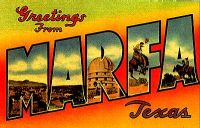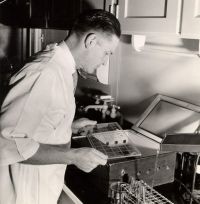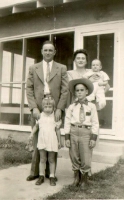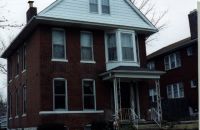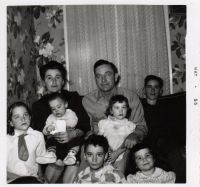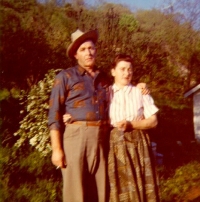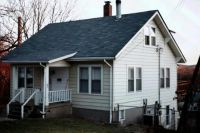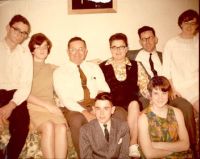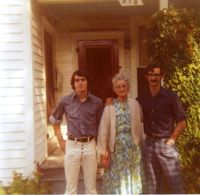|
Steven Vardiman (1949-Present)Illinois, Texas, Missouri, Colorado, Utah |
||
Photos: |
Content:Age: Occupation: Engineer State: Illinois, Texas, Missouri, Colorado, Utah # of Children: 2
See below photos for narrative |
Links:
|
|
Steven was born at Siblings: Larry, Steven, Billie |
Steven 9 months old |
|
Litchfield, Illinois (1942 - 1949)Phil was in his own veterinary practice for about nine to ten years. "That was one of the best things we ever did." (Louise Carter Vardiman Robinson, 21 April 1997) The family moved out of town to a small country house where Phil Vardiman had his private practice. The Vardiman family of five lived in a relatively small house off highway 66. They had a big yard with a cherry tree. There was also a storm cellar for storing roots from the garden and to escape into when a tornado came. Phil Vardiman had a large building in the back for his veterinary practice with tables and cages. Litchfield was in a large milk producing area and much of the milk was shipped to St. Louis and Chicago. |
||
|
Moved to Marfa, TX |
Lab in Marfa, TX |
Father - Phil at the lab |
|
Family of 5: Phil, Louise, Larry, Billie, Steven |
Steven Age <1-3 |
|
Marfa, Texas (West Texas) (1949 - 1952)Phil’s health was continuing to fail and the doctor said they needed to get to a warmer climate so they moved to Marfa, Texas in 1949 when Phil was 34 years old. So Phil decided to work on his masters at Texas A&M. He bought a hay wagon and loaded it with all the families possessions and hauled it behind their old willie station wagon for the 1500 plus mile trip from Litchfield, Illinois to West Texas. Phil got a job at an experimental station in Marfa, Texas while he was going to school for his masters in veterinary science at Texas A&M. The experimental station was on an old airport. There was a circular drive with a group of buildings, an old barn, an office which was used for the experimental station and two houses. One house was for the Vardiman family and the other house was for Phil's assistant. Hundreds of cattle were dying at that time and autopsy's revealed extremely hard, yellow livers. Phil did research to diagnose the problem. He began to identify all the poisonous plants the cattle were eating out on the range as the source of the problem. To help educate the ranchers on what the poisonous plants looked like, Phil built "Poison Hill" as he called it in a garden area in the middle of the circular drive which was about 50 feet in diameter. He brought in dirt and built a little hill then planted all the different types of poisonous plants that he had identified in West Texas. When ranchers came over Phil would take them out to Poison Hill and show them what the plants looked like so they could better protect their Herfer and Long Horn cattle. Phil mixed up a concoction of poisonous plants and fed it to some cattle a little at a time so they eventually were inoculated so that if the cattle ate the poisonous plants on the range they wouldn't die. Phil did his master thesis on his research on the poisonous plants in West Texas. |
||
|
Moved to St. Louis, MO |
Christmas 1954 |
1952-1956 |
St. Louis, Missouri (1952 - 1956)In 1952 they moved the family to St. Louis, Missouri where Phil worked for Ralston Purina as a large animal veterinarian. On their way to Missouri Louise went into labor and had to be dropped off at a hospital in Hays, Kansas where their fifth child, Ann Lueece, was born. While in St. Louis their last child was born, David. Phil and Louise purchased a fantastic, beautiful house in St. Louis on Dale Avenue in Richmond Heights. It was about one block from St. Lukes Catholic church. They lived in that house for about three to four years. It was four stories including the attic and basement. Larry has very vivid memories of the house. It had a front porch with a big beautiful glass door with beveled edges. Inside the door was an entranceway and to the right was a settee and a place to hang hats. On the right beyond that was a stairway leading to the second floor. Left of the entrance way was a sitting room with sliding mahogany doors that opened and closed like going into a drawing room. The ceilings on both floors were 14 feet tall with very fancy wall boards on the floor and ceiling. In the drawing room to the left was a beautiful ornate working fireplace with white enameled columns. It had a metal cover to keep out the draft when you weren't using it. There were also big old casement windows around the room. Beyond that was a dining room that also had big sliding doors between the rooms to petition them off. The dining room also had a fireplace on one end and big windows. Off to the right of the dining room was the kitchen or you could get to the kitchen from the front door by going straight down the hallway. It was a gigantic farm kitchen with a cupboard off to the side and white cabinets. There was a big screened in porch in the back. The second floor had four bedrooms and one bathroom. The front room was a children's room that looked out onto the street where you could see traffic and buses going by. There was a wooden window seat that lifted up for storage. In the back was another children's room which Mom and Dad painted the walls black so the kids could write on the walls with chalk. The other front bedroom had a fireplace as it was above the drawing room. The back bedroom on that side had fancy cabinets and closets. The bathroom had a big tub with a shower. The porcelain sink was from the 1930's or 1940's and had a column as the base. There was a very narrow stairway with only one lightbulb from the second to third floor. It was kind of creepy to go up the stairs but once you were in the attic it was bright with lights and windows in the front and back. The attic had sloping ceilings and was one big room. There was storage up there but still plenty of room to ride a tricycle around on rainy days. The basement had a coal furnace with pipes running along the ceiling that you had to duck under at times. There was a coal room and the floor was uneven. There was also a back door that led outside from the basement. "Dad often changed the houses we lived in. Our family joked how we always lived in sawdust." (Larry Vardiman, Glimpses of My Childhood, tape #1B) Phil didn't like eating in the dining room so he cut a hole in the wall between the kitchen and dining room about a foot high and made a table/bar situation. Half the family would sit in the kitchen and the other half in the dining room to eat but couldn't quit see each other. Dad did a similar thing in another house in Pacific, Missouri with a pull down table on a pulley arrangement. Phil did the carpenter type changes in the house and Louise did more of the painting and papering on the inside. She wanted the house to look sophisticated and wanted a patriotic theme in the front hallway. She had Larry, who was in his upper grade school years, fifth-seventh grade, paint the ceiling light blue and use a roller with a star pattern to roll on top. Then they painted the walls burgundy or dark red with blue stripes running vertically up the walls. We "ended up with a front hall that was very unique with a patriotic theme with stars and stripes and red, white and blue." (Larry Vardiman, Memories of My Childhood, tape #2A) While in St. Louis, Phil worked for Ralston Purina Company. He worked downtown at the veterinary center before going to the Ralston Purina farm full time. He did research projects with cattle. He got an idea from a Swedish man to operate on a cow and cut a hole in the side of the cow and into the stomach and install a pipe with a plug in it. He could insert feed into the stomach and see how long it would take to digest food. "I remember occasionally helping dad when I was out on the farm when he would remove the plug from that cow. Unfortunately the cow had built up a bit of steam from the digestion and when he would remove the plug it would squirt all kinds of nasty fluid out of the cow as well as all the gases and stinch that came with it. Anyway that was quite an experience." (Larry Vardiman, Glimpses of My Childhood tape #1B) Phil also drove out to the Ralston Purina farm for buckets of raw, non-pasteurized milk on Saturdays. He would take three gallon buckets and put wax paper with a lid on top. Some milk still spilled so the car always had a spoiled milk smell. |
||
|
Moved to Columbia, IL |
John Deere Model A Tractor |
International Harvester Farmall H |
Columbia Illinois, (1956 - 1959)They got tired of living in the city and decided to move out to a rustic farm in Columbia, Illinois in 1956 where Phil did a lot of fixing up of the place. The farm was on 102 acres of land. Fifty of the acres were full of trees and sinkholes and had a creek running through it. It wasn't possible to farm that area but it was great for rabbit hunting. The other 50 acres were tillable and Phil and Larry put in hay and corn. Since Phil was still working full time at Ralston Purina Larry did most of the farming. He learned a lot about repairing farm tractors and equipment. "It was a real neat experience. Probably one of the formative experiences of my life to be able to work on a farm like that and to learn how to do things that you just wouldn't get if you were a city kid." (Larry Vardiman, Glimpses of My Childhood tape #1B) The land and two story barn were o.k. but the house was in pretty bad shape. It was a 150 year old log cabin that someone had put electric wiring in it that ran along the ceiling and down to the switch box. The prior owners had used the kitchen as a barn for their sheep or goats. The "first thing we had to do was shovel out three inches of goat manure out of the kitchen. It stunk to high heaven. After we shoveled it out, washed it down and disinfected it then we painted it the color mom selected, pea green. It looked pretty sad but it was a gigantic kitchen with a big farm table in it." (Larry Vardiman, Glimpses of My Childhood, tape #1B) There were only two bedrooms in the house. Their parents used one bedroom and all six children shared the other large room. It actually had six beds in it! There was no running water or septic system. To go to the bathroom required a walk about a block long down to the outhouse behind the barn. Phil put in a pressure pump system for running water and a heater for hot water. Then he built a septic system from bricks. Larry remembers helping dig the hole in the ground and standing at the bottom laying bricks for the septic tank. "It was kind of a strange way to live but that's the way my dad and mom did it and it worked. They got it built into a nice home." (Larry Vardiman, Glimpses of My Childhood, tape #1B) When Phil and Larry plowed one of the fields for the first time it was rather challenging as the weeds were over ten feet tall in one area as that field had probably not been plowed in over five years. They used an international cub tractor which was actually only a garden tractor with one plow. Since they couldn't see from one end of the field to the other Larry said, "The first time we plowed that field the way we had to do that was Dad got on the tractor and started at one end of the field and I stood up on top of the tractor and looked at the trees at the other end of the field and told him which direction to head because he couldn't see even if he stood up on the tractor… So I had had to stand up on the hood of the tractor and look out across the field and see above the weeds in order to be able to plow the first furrow straight. Once you got the first one in it was pretty easy after that." (Larry Vardiman, Glimpses of my childhood, tape #2B) It typically took Larry about a month to plow ten acres of land with the small tractor going about the speed of a mule. There was a steep hill behind the barn and the tractor didn't have enough power for hauling large loads of hay and would buck up in front or slip in the mud. "Grandma Mollie Vardiman was visiting one time and I was kind of showing off and I popped the clutch a little bit and the front end of the tractor went up in the air like a bucking bronco and she screamed and about scared the daylights out of me from her scream but then it settled back down and we were ok." (Larry Vardiman, Glimpses of my childhood, tape #2B) Phil later bought a 1938 or 1939 John Deere model A tractor with a big flywheel and two pistons. It made lots of different noises depending on what type of terrain it was on and it just kept on going. One year rain got into the exhaust pipe and into the oil shortly after Larry had overhauled it in shop at school in Columbia. When Phil started it up the oil was frozen and it burned up the engine. Phil bought a used International Harvester Farmall H four-cylinder tractor which they used for the last year and a half they lived on the farm. |
||
|
Moved to Pacific, MO |
Steve played Saxophone |
Steve's Rabbits |
|
|
Frank & Mae Carter Wedding |
1965 Steve - Cadet |
|
Gemini Space Project |
|
1966 Steve at Daytona Beach Family Midwinter vacation |
|
|
1967 Steve - High School Graduate |
Back Row: Steve, Billie, Phil, Louise, Larry, Mary Phil |
Pacific, Missouri (1959 - 1967)Phil’s health was getting worse so Ralston Purina gave him a job transfer to a research farm near Gray Summit, Missouri. It was too far to commute from Columbia so the family once again moved to Pacific, Missouri in 1959. They
bought a house on a dead end street on the East side of Pacific up next
to limestone cliffs. It was close to a factory that made roofing
materials, toothpaste and cleanser using ground up limestone. It was at
the edge of town and in the woods.
Steve went to Missouri School of Mines in Rolla from 1967-1971. Phil died from heart trouble on 23 February 1968 at 53 years old. Phil and Louise had been married a total of 27 ½ years! |
||
|
1972 David, Grandma Vardiman, Steve |
1972 Larry's house in Fort
Collins, CO |
Steve married Barbara Knote in 1971. They had two daughters: Tracy and Julie. |




